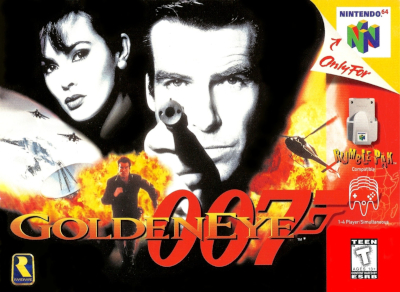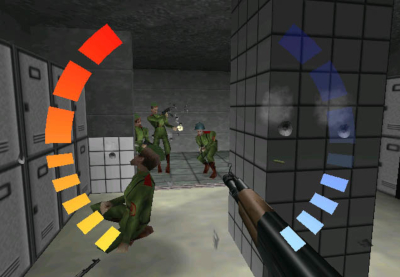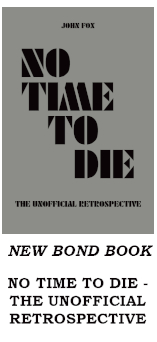|
‘GoldenEye 007’: James Bond’s Golden Game Turns 25

When
cameras first rolled on Pierce Brosnan’s James Bond film debut
GoldenEye on 16 January 1995, little did people imagine that this film
would save the franchise at a time when many doubted Ian Fleming’s spy
would survive the 1990s. But they were even less aware that, at that
precise moment, the foundation stone was cast for a video game that
would revolutionize the industry in unexpected ways.Twenty-five
years after its release, GoldenEye 007 is still regarded not only as
the best Bond video game of them all but as one of the best video games
ever made. This was a huge compensation considering that the game was
made by a group of people who had barely worked in the video game
industry (some had no experience at all) and that subsequent delays
resulted in a release nearly two years ahead of the premiere of the
film on which the game was based. Development
of this product began as early as the film started production, in
January 1995. No big deal was made at the time; a deal was signed
between the Japanese video game company Nintendo and Danjaq, the
holding company representing the rights of the big screen version of
007, to produce an interactive adventure based on the next Bond film.Throughout
the 1990s, video game adaptations of hit films were just another
marketing strategy and most of them did not have a good reception,
given all the limitations of dealing with a licence. This GoldenEye
game would be just another product, like the Corgi die-cast replicas of
the BMW Z3 or the plastic Walther PPKs firing caps. Little did they
know this would be the most celebrated piece of merchandise attached to
the secret agent in the next quarter of a century.Developers
working at Rare, the Twycross-based game company in charge of the
project directed by Martin Hollis, visited the many sets of the film
designed by Peter Lamont inside the vast abandoned airfield that would
soon become Leavesden Studios. They were given access to the blueprints
of each set, they took reference photos of the costumes worn by each
character and artist B Jones used production stills of actors Pierce
Brosnan, Sean Bean, Izabella Scorupco and Famke Janssen to create their
polygonal 3D models. Limitations of hardware prevented the use of voice
recordings, so the dialogues were presented on a black box on top of
the screen.While initially the
product was meant as a driving game for the short-lived Virtual Boy
console and a 2D version for the Super Nintendo system was planned, the
project was then delayed to become one of the launch titles of the
Nintendo 64 console in June 1996. This way, the game evolved into a 3D
“on-rails” shooter in the style of Sega’s popular Virtua Cop arcade: a
camera would zoom into enemies trying to get a shot at the player and
take you to different areas to accomplish several objectives.Even
at this stage, innovative ideas were proposed: guards taking cover and
triggering alarms, different kinds of weapons, Oscar-worthy death
animation for enemies and bullet holes remaining in the walls. Sound
also played an important role, as this time the loudness of weapons
mattered: shooting a couple of enemies with a silenced PP7 (an in-game
variant of the Walther PPK) would allow the player to move stealthily
through an environment, but using a more powerful weapon like the KF7
Soviet (the fictional version of the AK-47) would attract
reinforcements and complicate the progress of the player.Ken
Lobb, a Nintendo of America representative joining the team, suggested
the team should drop the on-rails style in favour of a first-person
shooter. This genre offered every level seen from the viewpoint of the
protagonist (in this case, Bond) and allowed freedom of movement: the
player could move forward, backward, to the sides and explore the level
freely without having to follow a determinate route. Hollis was
sceptical at first since first-person shooters back in the day were
more popular for PC than consoles. However, when the first footage of
the game was shown at the Shoshinkai exhibition in Japan on 24 November
1995 (just as GoldenEye went on general release in the United Kingdom),
attendants saw the game as a first-person shooter. And so, the project
director was convinced that they should take this kind of approach as
risky as it may look. This change would lead to one of the
best-remembered aspects of the title.Unlike
most video games of the time, GoldenEye 007 would have areas and paths
that took the player to nowhere but allowed him to explore the maps
designed by Karl Hilton and Duncan Botwood. Naturally, there was a
route to the goal, and the key to that locked door was either on a desk
of an office or held by a guard, who dropped it after dying in a
confrontation. Instead of moving to a point to another shooting
everything coming across to you, GoldenEye 007 required the player to
complete a list of objectives before reaching the goal if you wanted to
move on to the next mission: destroying the wrong computer, killing the
wrong person, forgetting to photograph evidence would have grave
consequences for the player. This idea was taken from Nintendo 64’s
launch title, Super Mario 64. Unfortunately, all these additions caused
yet another delay of the title and Rare missed the chance to tie the
game’s release to the home video launch of GoldenEye in May 1996.Most
of the 18 levels of the game were straightly adapted from moments seen
in the 1995 film: the first mission had Bond walking through the dam
and bungee-jumping and it all ended with a shootout between 007 and 006
on the radio transmitter cradle in Cuba. Some situations were expanded
to offer a more complete experience: the player had to evade guards and
perform a series of activities before taking that breathtaking leap off
the dam, contact a double agent disguised as a scientist to get to a
room to meet 006 in the Arkhangel facility and rescue some hostages as
Xenia Onatopp tries to steal the Tiger helicopter (renamed “Pirate” in
this version). Other levels were more original: at one point, Bond had
to blow up a missile silo in Kirghizstan which served as a cover to
launch the GoldenEye satellite; or he had to escape from a cell inside
the Severnaya installation using a variant of Live And Let Die’s
magnetic watch, meeting and rescuing Natalya Simonova in the process.Two
bonus levels were rewarded to the player whenever he completed the game
in the two biggest difficulties, named Aztec and Egyptian. As most of
the members of the team were Bond fans, these missions were based on
older 007 adventures: Aztec placed Bond on a shuttle launch platform
inside the ruins of Teotihuacán, and he had to reprogram one of Drax’s
shuttles battling those yellow-attired guards with laser weapons and
the (almost) indestructible Jaws; in Egyptian, Baron Samedi challenged
Bond to recover Francisco Scaramanga’s Golden Gun, guarded by him in an
ancient temple in the fictional region of el-Saghira.The
team’s love for the classic Bond was the cause of many references to
the series, such as a sniper rifle that looks very much like the
Walther WA2000 used by Timothy Dalton in The Living Daylights and a
camera with a “007” engraved reminiscent of the one Bond uses in
Moonraker. But the biggest homage came in the Multiplayer mode, where
players could pick Jaws, Baron Samedi, Oddjob and May Day for a
“deathmatch” confrontation.The
game’s successful multiplayer mode, which was created only weeks before
the launch of the game, had an even bigger homage to the pre-Brosnan
days: Sean Connery, Roger Moore and Timothy Dalton were modelled as
characters and could be chosen for authentic “Battle of the Bonds”.
Huge detail was infused into this aspect as well, with the actors’
faces again scanned from publicity photos and screen captures, and the
tuxedoes adapted from their distinguished fashion styles: Connery wore
the ivory dinner jacket and red carnation, Moore wore a black
double-breasted tuxedo and Dalton had his tuxedo unbuttoned.
Regrettably, this idea came as the developers thought they had free
access to the entire Bond universe and ignored the individual rights of
the actors involved, so this “All Bonds” option was disabled in the
final product.GoldenEye 007 was
released in North America on August 25, 1997, and it was an instant
hit, praised by critics and gamers alike with top marks. With each
passing year, the title sold more and more copies and it became the
third best-selling Nintendo 64 game, totalling around eight million
copies sold when the console was discontinued in 2002. Its impact was
so huge that game studios felt more confident in releasing first-person
shooters for consoles and based on real-life situations after most of
them generally put the player in a fantasy context with monsters or
aliens. The game was an introduction for many to the world of James
Bond and its impact not only prompted new fans to rent or buy the 1995
film but to explore the earlier chapters of the franchise and get
interested in the following Pierce Brosnan adventures as they hit
cinemas.
Not
everyone, however, was too pleased with the outcome: it is understood
that after EON Productions and Danjaq knew of GoldenEye 007’s
popularity and discovered the amount of violence and blood the game
had, they established bigger restrictions for the Bond titles then
released by Electronic Arts and Activision, film adaptations or
original stories such as 007 Nightfire, 007 Everything or Nothing and
Blood Stone. This would mean
that the player would be encouraged to take a stealthier path than
shooting his gun around, and being detected would mean the immediate
failure of the mission in many cases. Ironically, the impact of the
Nintendo 64’s golden cartridge was so overwhelming that GoldenEye 007
is the product every new Bond game was compared to, particularly those
who were first-person shooters and the aforementioned changes by the
holders of the licence, who favour a tighter approach instead of the
“free world” style of the 1997 title, weren’t well appreciated by the
community. Another proof of
GoldenEye 007’s success is that both Electronic Arts and Activision
tried to take a shot at the game’s popularity in the past 25 years: in
2004, EA released GoldenEye: Rogue Agent, a spin-off story where the
player would not be Bond but a brutal recruit dismissed by MI6 and
joining Auric Goldfinger’s in a gang-battle the man who loves only gold
is having with Dr Julius No, all set in a pseudo-futuristic world.
Despite having Christopher Lee giving his voice for Scaramanga, Judi
Dench providing the voice for M and Ken Adam recreating much of his
classic sets, the title was instantly seen as a way to cash in with the
name of GoldenEye while providing a radically different style of game,
turning out to be a critical and commercial failure. Much
more successful was Activision’s 2010 reimagining of GoldenEye 007 for
Nintendo Wii, starring Daniel Craig as James Bond. Bruce Feirstein
readapted the script of the 1995 film, setting it in the current times
and thus eliminating all references to World War II and the Soviet
Union and making “the bankers and their bonuses” Janus’ revenge
motivation. This game sold well and many critics praised it, but many
agreed that this product could not even reach the heels of the Nintendo
64 game. The playability was exaggeratedly similar to the Call of Duty
franchise, and the new versions of well-remembered characters like Alec
Trevelyan, Xenia Onatopp and General Ourumov only reminded us why Sean
Bean, Famke Janssen and Gottfried John could never be replaced in any
form. The ever-lasting legacy of
the original GoldenEye 007 and the frustration of fans on the way each
new Bond game was handled took them to try to make freeware adaptations
of the 1997 game using new technologies, improving some of the
limitations of the original and giving a better look to the
cardboard-looking maps of the N64 title. Some of these fan attempts
were asked to “cease and desist” by the Bond copyright holders, others
could release them by changing characters' names and all references to
the 1995 film staying with assets not involving the Bond licence.
GoldenEye: Source, a conversion of the popular Half-Life 2 shooter for
PC into the multiplayer mode of the N64 game, remains active since its
general release in 2010.In
February 2021, when a high-definition version of the Nintendo 64 game
for the Xbox Live Arcade system set to be released in 2007 was leaked
into the internet, that was a great day for a generation. This “port”
-the way a video game is called when is adapted from one console to
another- was originally planned for a 2007 release, and cancelled when
negotiations between the involved corporations fell. The game file,
leaked by an individual known as “Fyodorovna” (Natalya’s middle name in
the film), still had a couple of bugs and things that needed to be
fixed, but it was still fully playable and millions of gamers and Bond
fans could relive the beloved icon in better image quality. Needless to
say, many experts in 3D modelling have already found ways to fix all
those bugs, offering an almost-perfect version of this title around the
web.In September 2022, rumours
regarding a new release of the game were confirmed as Nintendo and Rare
announced the return of GoldenEye 007 for Nintendo Switch and Xbox Game
Pass set for 2023. The Switch version offers online multiplayer, while
the Xbox variant will keep the traditional split-screen multiplayer
only but the game will have high-definition graphics. Will the world be
enough for this generation growing up with GoldenEye? Probably not,
since many gamers have already pointed out that this new official
version –unlike the leaked XBLA port– does little to improve the
experience of what we can enjoy with an N64 emulator. Still, for those
who grew up with this game, its source film or Pierce Brosnan’s James
Bond, it’s always a pleasure to see the hype and appreciation for this
gem renewed in some form.-Nicolás SuszczykNicolás
Suszczyk is a freelance writer born and living in Argentina who became
a James Bond fan aged 7, shortly after watching GoldenEye on its cable
TV premiere in early 1998. His most recent book, The Golden Games of
Bond: A Total Summary and Analysis of the GoldenEye Legacy is now
available on Amazon.
© 2022
Alternative 007
|



|






